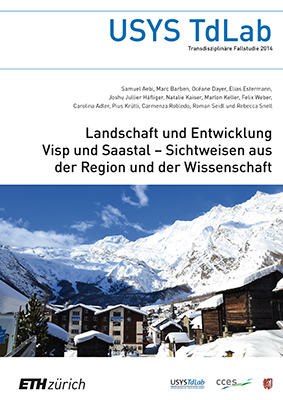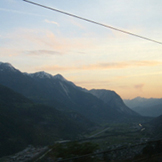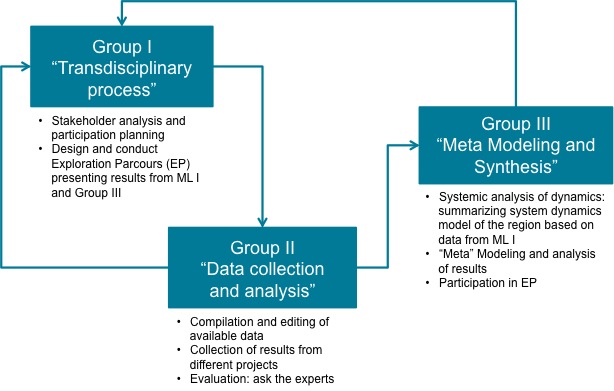CS 2014 "Mountain Ecosystems and Global Change in the Valais (Visp region, Saas Valley)"
Latest news

Aebi, S., Barben, M., Dayer, O., Estermann, E., Häfliger, J., Kaiser, N., Keller, M., Weber, F., Adler, C., Krütli, P., Robledo, C., Seidl, R. und Snell, R. (2014): Landschaft und Entwicklung Visp und Saastal – Sichtweisen aus der Region und der Wissenschaft. USYS TdLab Fallstudie 2014. USYS TdLab: Zürich. doi: external page10.3929/ethz-b-000628962call_made
- 2014/06/17: Media report (in German) on the case study 2014 at external pageRadio Rottu Oberwalliscall_made
Information about the case study
- DownloadShort Information (PDF, 1.1 MB)vertical_align_bottom (in German, updated 2014/01/14)
- DownloadOverview (PDF, 4.7 MB)vertical_align_bottom (updated 2014/01/14)
Evaluation of the outreach of the Mountland project’s first phase (2008 – 2012), an inter- and transdisciplinary project funded by the CCES (Competence Center Environment and Sustainability)

The "Mountland" project started in 2008 with the goal to establish a research network analyzing the provision of mountain ecosystem goods and services under global change in an integrative framework. The project had an inter- and transdisciplinary structure. Stakeholders from the region have been involved to different degrees at different project phases. Several workshops have been conducted. The questions for the TD Case Study 2014 are If and what project results have had an impact in the region? Can one measure some direct or indirect outreach?
Master students from ETH Zurich (Master Human-Environment Systems) address these questions together with a core panel of scientists and stakeholders form the region.
Advisory board with representatives from science and practice
- Prof. Harald Bugmann, Institute for Terrestrial Ecosystems, ETH Zurich
- Dr Andreas Rigling (Mountland project leader), Head of the Research Unit Forest Dynamics; WSL
- Dr Robert Huber (Mountland project coordinator), Research Unit Forest Dynamics, WSL
- Prof. Willi Zimmermann, Institute for Environmental Decisions, ETH Zurich
Results of Mountland I
There are several synthesis-documents on results from the first phase of the project documented in scientific Journals, sectoral Journals (e.g. Agrarforschung Schweiz) and reports directly addressing stakeholders. This data will be compiled and re-analyzed for stakeholder-interaction. Moreover, there have been other projects conducted in the region. Their results also can be considered: Cluster Water management of NFP 61; MontanAqua; Regalp; Alpfutur; econcept; ACQWA (Swiss Rhone Catchment).
In the TdCS 2014, we work in three (linked) groups of students, each tutored by post docs or senior researchers:

- Group I is responsible for the transdisciplinary process including actor analysis. Different actors from different sectors dealing with different factors are to be approached and invited to workshops and evaluation events.
- Group II compiles, analyses and prepares the results from Mountland I. The group uses appropriate methods to elicit experts’ evaluations of these results.
- Group III uses the System Dynamics approach to develop a simple meta model of the main ecosystem and social dynamics found by the Mountland project. The outputs of this model are then compared to the project’s scientific model results regarding its perceived usefulness among stakeholders.
Students
Samuel Aebi, Marc Barben, Océane Dayer, Elias Estermann, Joshu Jullier Häfliger, Natalie Kaiser, Marlon Keller, Felix Weber
Tutors
Carolina Adler, Carmenza Robledo, and Rebecca Snell
Headship
- Dr Pius Krütli
- Dr Roman Seidl
- Support: Sandro Bösch, USYS TdLab
Timetable
- 2013, December 3 (Tuesday), 17:15 • First information for students
- 2014, February 21 – 22 • Kick-off meeting in Visp; Students and advisory board.
- 2014, February 19 – May 28 (Wednesday afternoon, 13 – 17h)
- 2014, April, 23 – 25 • block week (~3 days)
- 2014, June 2 – 18 • block week
Publications
- Aebi, S., Barben, M., Dayer, O., Estermann, E., Häfliger, J., Kaiser, N., Keller, M., Weber, F., Adler, C., Krütli, P., Robledo, C., Seidl, R. und Snell, R. (2014): Landschaft und Entwicklung Visp und Saastal – Sichtweisen aus der Region und der Wissenschaft. USYS TdLab Fallstudie 2014. USYS TdLab: Zürich.
